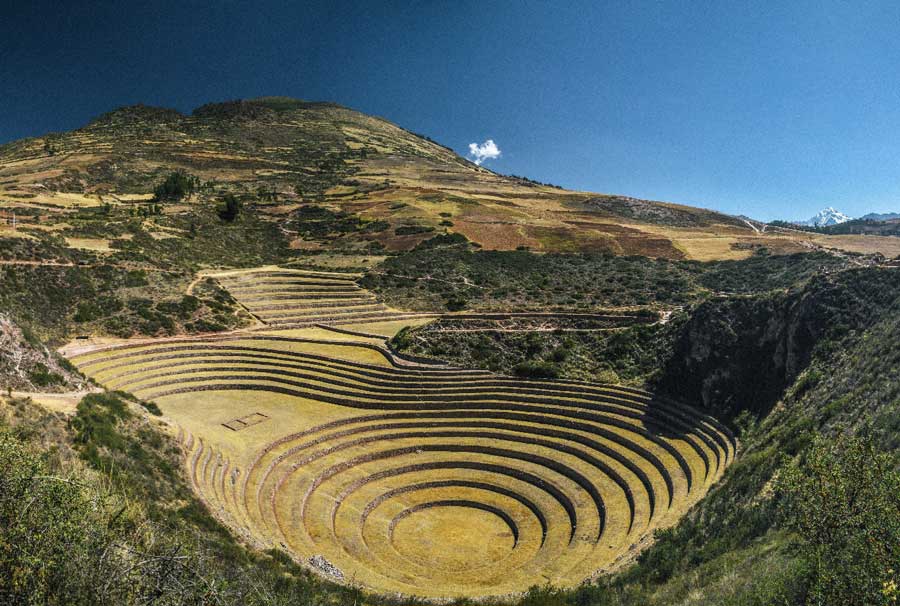Andean Agriculture: What Were The Inca Building At Moray?
In the South American nation of Peru can be found the ruins of the last Pre-Columbian civilization, the glorious Inca Empire. What was once a thriving, rich civilization is today’s tourist attraction. Nestled in Peruvian mountains and valleys, the Inca culture still stands to retell the history of a thousand years ago. While Peru has many Inca ruins, one place of particular interest are the strange structures at Moray.
Situated in the central Sacred Valley region just outside of the Inca capital of Cusco, these ruins are a testament to the Inca lifestyle and livelihood. But what the Inca were building at Moray remains puzzling. It seems to have been some kind of agricultural experiment, one which left some of the most complete and unusual ruins this vast empire has.
Hidden in the Mountains
It is said that the city of Cusco was once the epicenter of the Inca Empire. It is, therefore, not a surprise that the vast and stunning Moray ruins are located merely 50 km (31 miles) away from present-day Cusco.
They can be found to the west of a small village called Maras, famous for its salt flats. These ruins are located at an altitude of 3,500 m (11,500 feet) above sea level, high in the perishing cold of the Andes.
What Is A “Moray”?
The word Moray has different meanings in different languages. In the Incan Quechua language, Moray translates into land occupied since ancient times. Given that the structure and surroundings of the Moray circles still remain largely intact – it is almost a disservice to call them ruins – the way the Inca people created them does full justice to the name’s meaning.
However, there are other meanings behind the name. Some people believe that the name Moray comes from “Anymoray” or the month of the Inca calendar associated with the corn harvest.

60% of the world’s staple crops come from this part of the Andes, including almost 2,000 types of potato (Jenny Mealing / CC BY 2.0)
Some historians believe that Anymoray was the Inca name for the month of May, which signified the month for planting crops in Inca culture. Because the Moray ruins seem to be an ancient agricultural laboratory used by the Inca people, it makes sense that its name comes from different agricultural activities, or land set aside for that purpose.
Or maybe it is just one of the many Andean words for “potato.” Specifically, dehydrated potatoes are known locally as “moraya” and this association with food preservation and agricultural planning seems appropriate for what was being attempted here.
Circles In The Rock
Certainly Moray is beautiful. Several vast bowl-like depressions fit into the natural shape of the landscape, with concentric terraces descending down to a central open space far below. The overall look of the entire structure is something like a natural amphitheater.

The structures take advantage of the natural shape of the landscape (Katarzyna / Adobe Stock)
This matches with the scale of the terraces, with the largest being at the center of the structure and the smallest in size around the outer circle. The circles grow gradually thinner as they go out of the structure, taking the shape of a ripple or descending circular steps.
The circles go down to a depth of almost 150 meters (500 feet). The descending circular terraces drain into one another, and the true genius of the Inca construction is that even the central circle never truly floods.
The circular terraces are too high to easily scale, but are connected by multiple staircases that help in going from the top circles to the bottom one easily. Six more terraces in elliptical shape also surround the concentric shapes of the main terraces, following the natural shape of the valley sides.
Each descending circle therefore offers irrigated soil, and each circle is therefore slightly different. This is what has led to the conclusion that the Incan people used to practice terrace farming here. Differing crops would thrive in differing terraces, and the graduated construction allowed the Inca to experiment, and find the ideal growing conditions for their food staples.
There are eight terraced steps that connect the circles to the ellipses, offering further variation in climates for growing crops. And it is very likely that the experiments conducted here allowed the huge Inca empire to feed its people.
The Microclimates Of Moray
Much of the heart of the Inca Empire is not ideally suited for agriculture. The Andes here are truly enormous, and the altitude leads to sudden spells of cold and harsh winds. Against these natural challenges, the depth, design, and location of the terraces created varying conditions allowing for differing temperatures and wind speeds.
Further, the drainage system ensured that different circles receive different amounts of water, and the more sheltered lower terraces even have their own microclimates. Between the top and the bottom-most circles of the Moray ruins, there is a difference of 15 degrees Celsius (27 degrees Fahrenheit).
This creates different climatic conditions in each of the different terraces. Moreover, so much of the site has remained intact that even today the soil samples from Moray show a distinct variation in composition. It seems the Inca imported different types of soils taken from across their empire here and that their experiments would have far reaching benefits.

Each terrace appears to offer a unique growing environment for crops (McKay Savage / CC BY 2.0)
The presence of microclimates, different drainage systems, and a complex soil composition shows how sophisticated this agricultural laboratory was. This would be where the Inca perfected their domestication and mass production of some of the 2,000 varieties of potatoes and other staple crops that originate in this part of the Andes.
A Vanishing Legacy
Another fascinating fact is that even with heavy Peruvian rain, the Moray circles remain well irrigated but never flood completely. Historians and scientists believe that the Incan people may have built underground channels for better drainage even during heavy rainfall.
Thus, the greenhouse-like Moray circles had detailed planning behind them, and this planning and the durability of the Incan construction methods are why we are able to understand so much about the site today. However, there is still a threat of erosion and decline with climate change and time.
For example, during the 2009-2010 period, the Moray circles and Cusco received unnaturally heavy rainfall that caused permanent damage to the ruins. The ground beneath the structure eroded partially due to rainwater flow, which led to the partial collapse of the structures.
Authorities erected a temporary wooden scaffold around the structure to stop further erosion and damage. Repair and restoration work still continues at Moray to preserve the original structure.
However, climate change and heavy rainfall continue to impact the Moray ruins. Historians and researchers are of the opinion that Moray ruins need further repair and maintenance to stop further degradation.
The Moray ruins are an architectural and scientific wonder, and stand in mute testimony to the ingenuity of the Incan empire. The scale and sophistication of this agricultural experiment shows the importance this Andean civilization placed on feeding its people, and how well they learned to work in harmony with the landscape to thrive deep in their mountain fastness.
Top Image: The terraces at Moray. Source: Alisha / Adobe Stock.
By Bipin Dimri
References
Moray: The Mind-Boggling Inca Ruins near Cusco. Available at: https://www.peruforless.com/blog/moray
Moray Ruins. Available at: https://www.theonlyperuguide.com/peru-guide/the-sacred-valley/highlights/moray-ruins/
The Mysterious Moray Agricultural Terraces of the Incas. Available at: https://www.theonlyperuguide.com/peru-guide/the-sacred-valley/highlights/moray-ruins/
Inca Empire Culture. Available at: https://culturainca.net/en/inca-empire-culture/


















Comments
Obviously a work of the prior, pre-Ice Age (Atlantean-era) culture. First, let’s recognize that the global weather was hotter & wetter before the Ice Age suddenly hit – circa 115k BC, adding the zero back to Plato’s timeline. With that in mind, the design engineering of the layout suggests it was for the management of rainwater run-off. This photo (https://cdn.kimkim.com/files/a/content_articles/featured_photos/d0e2d25a...) shows where timber roofs (now missing) would have been part of the architecture, so we have to assume the area was largely forested back then, requiring a lot of work (hundreds of years?) to clear and grade it for the settlement. Also note the steep pitch of the would-be timber roofs suggests a lot of rain or possible for a snow-load. I’d guess they chose that elevation for their settlement because it was cooler (more comfortable) up there. Otherwise, they would have had to carve out caverns like they did at the lower elevations, particularly around the Med and ‘fertile crescent’.
Nobody gets paid to tell the truth.
However, there is the possibility that they were for a very different purpose.